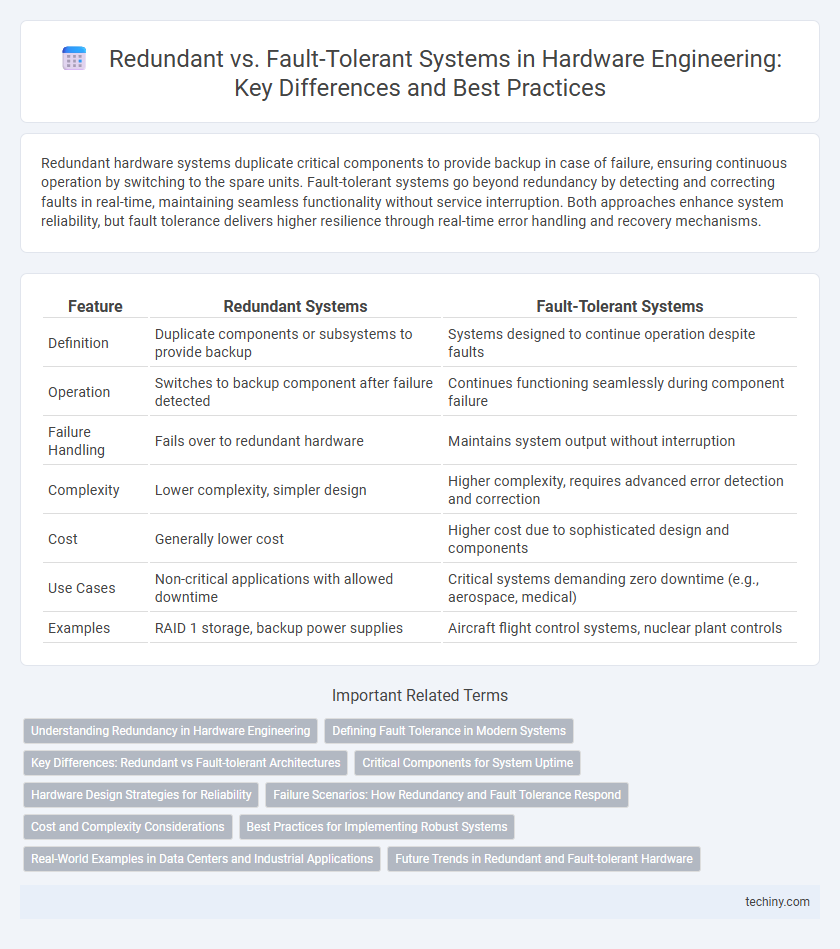Redundant hardware systems duplicate critical components to provide backup in case of failure, ensuring continuous operation by switching to the spare units. Fault-tolerant systems go beyond redundancy by detecting and correcting faults in real-time, maintaining seamless functionality without service interruption. Both approaches enhance system reliability, but fault tolerance delivers higher resilience through real-time error handling and recovery mechanisms.
Table of Comparison
| Feature | Redundant Systems | Fault-Tolerant Systems |
|---|---|---|
| Definition | Duplicate components or subsystems to provide backup | Systems designed to continue operation despite faults |
| Operation | Switches to backup component after failure detected | Continues functioning seamlessly during component failure |
| Failure Handling | Fails over to redundant hardware | Maintains system output without interruption |
| Complexity | Lower complexity, simpler design | Higher complexity, requires advanced error detection and correction |
| Cost | Generally lower cost | Higher cost due to sophisticated design and components |
| Use Cases | Non-critical applications with allowed downtime | Critical systems demanding zero downtime (e.g., aerospace, medical) |
| Examples | RAID 1 storage, backup power supplies | Aircraft flight control systems, nuclear plant controls |
Understanding Redundancy in Hardware Engineering
Redundancy in hardware engineering involves duplicating critical components or systems to improve reliability and prevent failure, often implemented through mirrored circuits, backup power supplies, or replicated data paths. Fault-tolerant systems build on redundancy by not only having duplicate elements but also enabling continuous operation despite component failures via error detection and correction mechanisms. Understanding redundancy is essential for designing robust hardware infrastructures that maintain functionality and minimize downtime in mission-critical applications.
Defining Fault Tolerance in Modern Systems
Fault tolerance in modern hardware engineering refers to a system's ability to continue operating correctly even when one or more components fail, ensuring uninterrupted performance and reliability. It involves strategies such as error detection, isolation, and correction mechanisms integrated at both hardware and software levels to prevent catastrophic failures. Modern fault-tolerant systems often combine redundancy with advanced diagnostic techniques to maintain system integrity under varying fault conditions.
Key Differences: Redundant vs Fault-tolerant Architectures
Redundant architectures duplicate critical hardware components to ensure system availability by switching to backups in case of failure, while fault-tolerant architectures continuously operate despite faults by using error detection, correction, and dynamic reconfiguration. Redundancy primarily targets hardware failure recovery through multiple identical units, whereas fault tolerance incorporates both hardware and software strategies to maintain seamless functionality during faults. Key distinctions include redundancy's reliance on discrete spare components versus fault tolerance's integrated error management and recovery mechanisms for uninterrupted operation.
Critical Components for System Uptime
Redundant hardware components such as multiple power supplies or duplicate processors ensure system uptime by providing backup paths that activate upon primary failure, minimizing downtime. Fault-tolerant systems integrate advanced error detection and correction mechanisms within critical components to guarantee continuous operation even during partial hardware faults. Prioritizing redundancy in power and communication modules alongside fault-tolerant CPU architectures significantly enhances reliability for mission-critical applications.
Hardware Design Strategies for Reliability
Redundant hardware design incorporates multiple copies of components to ensure system functionality when one fails, enhancing reliability through parallel resource duplication. Fault-tolerant hardware architecture employs sophisticated error detection and correction mechanisms, allowing continued operation despite faults without system interruption. Combining redundancy with fault-tolerant techniques optimizes hardware reliability, minimizing downtime and data loss in critical engineering applications.
Failure Scenarios: How Redundancy and Fault Tolerance Respond
Redundancy in hardware engineering involves duplicating components to maintain system operation during failure scenarios, enabling seamless switching to backup units when primary elements fail. Fault-tolerant systems go beyond simple duplication by integrating error detection, isolation, and correction mechanisms to ensure continuous functionality even under multiple simultaneous faults. In critical environments such as aerospace or data centers, fault tolerance provides superior resilience compared to redundancy alone, minimizing downtime and preventing complete system failures.
Cost and Complexity Considerations
Redundant hardware systems increase cost and complexity by duplicating components to provide backup in case of failure, often leading to higher material and maintenance expenses. Fault-tolerant designs integrate advanced error detection and correction mechanisms, which can reduce downtime but require sophisticated engineering and increased initial investment. Balancing cost with system reliability depends on the specific application's tolerance for failure and budget constraints.
Best Practices for Implementing Robust Systems
Implementing robust hardware engineering systems requires selecting between redundant and fault-tolerant designs to ensure continuous operation during component failures. Redundant systems duplicate critical components to provide backup functionality, while fault-tolerant systems employ error detection and correction mechanisms alongside redundancy for seamless system reliability. Best practices involve conducting thorough failure mode and effects analysis (FMEA), integrating real-time monitoring, and balancing cost with desired system availability metrics to optimize hardware robustness.
Real-World Examples in Data Centers and Industrial Applications
Redundant hardware systems, such as dual power supplies in data centers, ensure continuous operation by providing backup components that activate upon failure. Fault-tolerant designs use parallel systems that maintain real-time operations without interruption, exemplified by RAID 1 storage arrays in industrial control systems. These implementations minimize downtime and data loss, critical for maintaining high availability in cloud infrastructure and manufacturing automation environments.
Future Trends in Redundant and Fault-tolerant Hardware
Future trends in redundant and fault-tolerant hardware emphasize advanced predictive analytics integrated with AI to enhance system reliability and preemptively address failures. Emerging technologies focus on adaptive redundancy schemes that dynamically allocate backup resources based on real-time performance data, optimizing hardware efficiency. Innovations in fault-tolerant architectures leverage quantum computing principles and neuromorphic hardware to achieve unprecedented levels of error resilience and processing continuity.
Redundant vs Fault-tolerant Infographic

 techiny.com
techiny.com